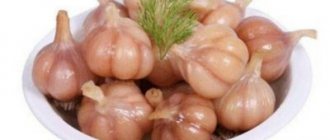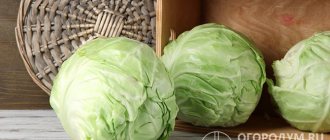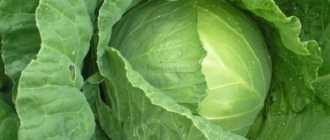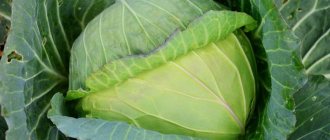Places
One of the best places to store a large volume of sauerkraut is the cellar.
For a city apartment, such places can serve as:
- Fridge.
- Pantry.
- Balcony equipped for vegetable storage.
- Less often - being on the street.
Even if you have adequate space for placing sauerkraut, you should take care of suitable containers.
Cellar
If the cellar meets all the necessary requirements for temperature and humidity, then cabbage can be stored in oak barrels.
If such containers are not available, use them in glass jars. The cellar is a suitable place to store preparations in the winter. But it is better not to leave fermented cabbage in it in the summer, since even in deep basements the temperature in summer rises above +5°C.
The cellar must first be treated - disinfected and protected from rodents.
Is it possible on the street, incl. in the cold?
A balcony or open veranda is not always suitable for storing food in the winter. On an open, unglazed balcony or veranda, you can store sauerkraut for a short time - only as long as the temperature outside is within the limits allowed for storing sauerkraut.
If you plan to store cabbage in the cold, then it should first be packaged in separate containers designed for one use.
In unstable weather conditions outside, when frost is replaced by warming, the workpiece may deteriorate. The way out of the situation is to move the containers with cabbage to the freezer of the refrigerator when warming is predicted.
At home, apartment
Sauerkraut is not stored directly in the room, in a city apartment, due to the high air temperature. Maximum - a couple of days.
For a longer stay in the house, one of the options can be used:
- fridge;
- pantry;
- balcony.
In the refrigerator at home
The small size of the refrigerating chamber imposes restrictions on the possible volume of workpieces. Glass jars or plastic containers are suitable for storage.
Long-term storage in the refrigerator can be accomplished by freezing. At the same time, all the beneficial substances are retained in the vegetable.
The disadvantage of this approach is the need to defrost sauerkraut under natural conditions, at room temperature, and this takes time.
After complete thawing, the vegetable can no longer be stored for a long time. It should be consumed within a few hours. Repeated freezing is unacceptable.
In the pantry
If your city apartment has a storage room, it can be used for storing fresh vegetables and preparations. The pantry is suitable for finding sauerkraut only if the following conditions are met:
- The temperature does not rise above +4 or +5°C.
- Sufficient humidity is maintained.
- There are no windows in the room or there is the possibility of darkening.
How to do it on the balcony?
Glazed but not insulated balconies, in most cases, have an air temperature practically no different from the street temperature. Because of this, you can use the balcony as a storage area for food preparations in cold weather only when it is freezing.
You can extend the time sauerkraut spends on the balcony by placing the container with cabbage on an elevated surface and additionally insulating it with a blanket or other things. This will prevent the workpiece from freezing.
In the case where the balcony has insulation, you also need to control the temperature, since at low temperatures the cabbage will freeze, and at elevated temperatures it will peroxidize.
Read about whether and how to store sauerkraut on the balcony here.
What factors affect quality and shelf life?
Cabbage variety
A lot depends on the type of cabbage. Sour cabbage of mid-season and late-ripening varieties is well preserved. It is what ferments for a long time and retains a pleasant crunch and dense texture. Early ripening varieties of cabbage are distinguished by the tenderness of their leaves and are more suitable for preparing salads or light soups, and it is better not to use them for preparations. Such cabbage will resemble boiled cabbage in consistency, and this is unacceptable in this case.
Cabbage varieties for pickling or pickling usually have juicy and very dense leaves with thin veins, which can be difficult to chop. The color of such heads of cabbage is very light, almost white. Vegetables with green leaves are in no way suitable for pickling, because such a preparation will most likely taste bitter.
Note: if you do not chop the leaves into thin strips, as is usually done, but cut them into large (up to five cm) squares, then the amount of preserved vitamins will be maximum.
Early ripening varieties are not suitable for fermentation, just like green leaves
Storage containers
You should not store sauerkraut in aluminum containers, as a reaction will begin between the metal and the acid, as a result of which the product will turn black and begin to taste bitter. Eating such a dish will not only be unpleasant, but also dangerous to health. Glass or enamel containers are the most suitable option.
Temperature and humidity
The storage conditions for pickled or sauerkraut are similar in terms of temperature; the ideal is considered to be from +2 ˚C to +5 ˚C. It will not be possible to store cabbage at elevated temperatures: it will quickly turn sour.
You can also freeze the product, if it is not possible to store it in ideal conditions, it is better to do it in portions. In addition, we must remember that repeated freezing will be disastrous for the product. but also very undesirable.
The storage temperature must be constant. It is recommended to store sauerkraut at a fairly high humidity; excessive dryness does not benefit this dish.
Mold protection
Late varieties of cabbage can be stored in pickled form for the longest time - up to six months, especially in the cellar, adding cranberries or lingonberries to the delicacy, which will help prevent the appearance of mold. Mustard and its seeds, as well as sugar, have the same properties if you sprinkle them on the finished product from time to time.
White cabbage is suitable for fermentation, giving better results in taste and storage
Brine quantity
Sauerkraut or pickled cabbage should be stored so that the brine completely covers the shredded leaves. If it becomes insufficient, you need to add the required amount of cool water with the addition of salt into the container with the workpiece. Cabbage fermented in large containers is specially pressed under pressure, because only when in brine will the product retain the incredible amount of vitamin C and other beneficial substances it contains.
Helpful advice: if the cabbage harvest has ripened in the beds for storage in pickled form, then these heads of cabbage can not be removed until the first light frost. In vegetables caught by the first frost, starch is converted into sugar, which gives their pulp a brighter and richer taste.
Choosing the right cabbage for pickling
For this purpose - pickling - only late-ripened varieties of cabbage are suitable. Therefore, the preparation is often done before winter and for a long time, fermenting a large volume of leafy vegetables so that it lasts until spring. Also, late-ripening varieties are chosen because of their increased density, which also increases the taste characteristics of the pickles.
Cabbage, which reaches technical maturity in the summer season, is a good addition to vitamin-rich vegetable salads. But when fermented, it cannot sit for long. Under the influence of table salt, the fibers of cabbage leaves of early and medium varieties soften, lose some of their vitamins, taste and do not crisp. At the same time, not all cabbage heads are suitable for pickling, but only those forks that meet the following characteristics:
- when squeezed, the cabbage head does not deform and retains its elasticity;
- there is no damage on the surface of the cabbage leaves;
- the stalk is light green or cream, without rings or other dark markings;
- The cabbage head does not have limp, rotten or frostbitten leaves.
On a note! For long-term storage of sauerkraut, you must follow all recommendations. If the forks have been damaged, the pickled vegetable will have a shorter shelf life.
Also, you need to take into account that early or middle varieties can be fermented, but such cabbage will only be tasty for a few days, then it begins to sour
How long can you store
Sauerkraut, like any other durable product, has its own shelf life. The following indicators are valid for various methods of its maintenance:
- When stored in a barrel, the product will remain fresh for about 8 months (at temperatures from -1°C to +4°C).
- Cabbage placed in a glass container retains its original qualities for no more than 2 weeks from the moment of its preparation.
Important! You can significantly extend the shelf life of snacks placed in jars by pouring a 2 cm thick layer of vegetable oil over them.
- With any method of laying out in containers at temperatures up to +10°C, cabbage will retain its condition for no more than 5 days.
If you keep it in plastic bags, the finished product will “last” in its normal form for no more than a week (at temperatures no higher than +4°C).
It is strictly forbidden to store it indoors, since the cabbage in this case turns sour very quickly. You can extend the shelf life if you put it in a small plastic bag directly in the freezer of the refrigerator.
It is important to remember that it cannot be re-frozen. When using a snack, you should only place in the freezer a portion that can be eaten at one time.
How to get rid of mold
When storing cabbage, there is always a high risk of mold (fungus) formation, which can completely ruin the fermented product and reduce all the housewife’s efforts to nothing. And this is after she has taken all possible measures to save it!
Also read: How to keep bananas fresh and healthy for longer
Some of the harvesters simply remove the accumulated mold from the top layer, but this most often does not help. The taste of the product after its appearance is completely lost and cannot be restored.
Additional information: Fungal mold spores completely affect it, and eating cabbage in this form can lead to intestinal upset.
To avoid these troubles, you must do the following:
- add a little mustard powder to the fresh preparation;
— place a bag of mustard seeds in a container (they have excellent antiseptic properties and protect the product from harmful microorganisms);
— cook cabbage with the addition of wild lingonberries or cranberries. These fruits of wild plants are natural antibiotics that work well against fungi;
— add finely chopped or thoroughly pureed horseradish to pots or jars with cabbage preparation, which blocks the process of reproduction of microorganisms.
Note that the horseradish additive can be introduced into the cabbage mass directly during the process of ripening.
How to store cabbage in winter?
When choosing ways to store cabbage, you should take into account the type of vegetable, size, freshness and density of the forks.
- For long-term storage, dense, full-bodied heads of cabbage with no or minimal air spaces are selected.
- More friable or soft specimens are selected for priority consumption and processing.
- The variety of the vegetable is also important: for high-quality preservation, only late-ripening varieties are suitable. Mid-season or early-ripening forks are suitable for fresh consumption or for preparing all kinds of preparations.
- Correct storage conditions for cabbage involve providing a high-quality microclimate and maintaining a temperature from -1 to +3 degrees with indoor humidity within 90-100%, which can vary depending on the type of vegetable.
How to store cabbage in the cellar for the winter?
The most common method used by most housewives is storing cabbage in the cellar for the winter. With such a storage room, it is possible to preserve fresh vegetables efficiently and for a long time.
- Cut heads can be stored in ventilated wooden or lattice plastic boxes. To do this, I place the fruits in one or two layers. The boxes themselves are installed on pallets made in such a way that air access from below is provided to the container.
- Cabbage can be arranged in a pyramid. The largest and heaviest heads of cabbage are placed in one layer on a wooden pallet. Smaller heads of cabbage are placed on top, reducing their quantity. The result will be a well-ventilated pyramid.
- The heads of cabbage can be hung at some distance from each other from the ceiling or beam. To do this, leave stalks with roots, which are pierced with wire or tied with rope.
How to store cabbage on the balcony?
Read more about how to store cabbage on a balcony or loggia. The method is inferior to the previous one in that in this case it will be much more difficult to ensure a constant cool temperature and humidity in the room.
- The balcony must be well insulated and glazed. In case of severe frosts and insufficient insulation of the walls, the heads of cabbage will need to be moved to a warmer place to avoid freezing.
- To preserve the juiciness of the vegetable, the forks are wrapped in paper and placed on shelves or racks in one layer or in ventilated rows.
- Proper storage of cabbage on the balcony in winter can be ensured by placing the heads of cabbage in lattice plastic or wooden boxes. The latter are placed on top of each other and covered with thick cotton fabric.
Storing cabbage for the winter in cling film
The use of cling film will ensure high-quality storage of cabbage heads while preserving their juiciness and proper taste. Forks wrapped in an accessory in two or three layers will remain fresh and unharmed longer than usual, and if one of the fruits begins to deteriorate, it will not cause rotting of nearby specimens.
- Heads of cabbage wrapped in cling film can be stored in boxes, bags or on racks in the cellar.
- Under proper climatic conditions on the balcony, forks packed in this manner will be stored for as long as possible.
- If there is free space, it is possible to store cabbage in film for the winter in the refrigerator.
How to store cabbage in the refrigerator?
An equally acceptable method, along with using the cellar, is storing cabbage in the refrigerator. Constant temperature and humidity in the device will allow you to enjoy the fresh and juicy taste of a valuable vegetable for as long as possible.
It is important to select high-quality fruits by trimming the outer dirty or spoiled leaves and stalk. To prevent the vegetable from starting to rot, it must be protected from drops of moisture or condensation. The forks are wrapped tightly in three layers of cling film or placed in a bag. Those who do not know how to store cabbage in the refrigerator need to remember that packaged heads of cabbage should be placed on a shelf with a minimum positive temperature. You can put vegetable specimens in the vegetable compartment if the refrigerator compartment of the device is set to the minimum permissible positive temperature regime.
Savoy cabbage - winter storage
The next section will help you figure out how to store Savoy cabbage for the winter. This variety is no more demanding on storage conditions than classic white cabbage varieties.
For long-term preservation, it is important to cut off the forks in dry weather or dry the vegetable specimens by hanging them with the stalk down in a dry, ventilated place
- Savoy cabbage can be stored in boxes, on racks or shelves in the cellar, basement or on the balcony.
- The heads of cabbage can be additionally wrapped in cling film or paper.
- In the refrigerator, the heads of cabbage in film are preserved no worse, or even better, than under any other conditions.
Useful tips
Sauerkraut is a valuable and healthy product. With its help you can diversify your family's winter diet. But for this you need to preserve the white vegetable.
Useful tips to help you do this:
- The preparation is stored well if heads of late-ripening and late varieties of cabbage, which were caught by the first frost, were used for fermentation. This preparation contains a lot of starch and sugar, so the vegetable turns out richly tasty and crispy.
- Features of the premises. The places where sauerkraut is stored should be cool and dark. It should be remembered that the sun's rays destroy vitamins and the vegetable darkens.
- In containers that are stored at a temperature of +1 - +5 degrees, there should always be brine above the chopped vegetables. Otherwise, the top layer of cabbage will become unusable and will have to be thrown away.
- Preparing containers. It is clear that any utensils must be clean and sterile. How to prepare jars for storing vegetables has already been said. If you use pots or barrels, you can resort to grandma's method. Sprigs of honeysuckle or dill are placed in a pre-washed container and filled with boiling water. The grandmothers still heated the stones and threw them into the barrel.
- Cover the top with a lid. Both dill and honeysuckle destroy pathogenic microflora. In such a container, sauerkraut is stored perfectly and does not become moldy.
- Selecting a container for fermentation. When using enamel cookware, you should be aware that chips and cracks not only shorten shelf life, but also negatively affect the quality of the product.
- Aluminum pans are not suitable for fermentation, as they oxidize. As a result, stored products become life-threatening.
- Plastic containers. You need to choose containers designed for storing food. When plastic comes into contact with acid, it can release harmful impurities.
How to preserve cabbage for the winter at home in an apartment
The task of how to preserve cabbage for the winter in the conditions of an ordinary average apartment is not so simple, but it is quite solvable. To achieve this, residents of skyscrapers will have to work closely on equipping their glazed loggias and balcony extensions. Only in this kind of premises is there a chance to achieve the required storage conditions for cabbage.
How to store fresh cabbage for the winter on an ordinary loggia/balcony.
Storage methods are the same as those used for cellar storage. You just need to avoid storing it in sand, soil, clay, etc. Technologies that include wrapping heads of cabbage in a paper or film cocoon are quite sufficient. Under such conditions, the shelf life of cabbage is approximately 3.5-4 months. The main thing is that the chosen room in winter should not be too cold or too warm, both of which contribute to the spoilage of vegetables. You can also successfully keep sauerkraut and salted cabbage there.
Well, how can those who are not lucky enough to have any of the mentioned cold rooms preserve cabbage? There is a way out, but alas, only one and not very profitable - a refrigerator. This household unit is available in every family and can partially solve this problem. Of course, even a large refrigerator won’t fit much. Nevertheless, a couple of small heads wrapped in film or a container of sauerkraut can be safely placed and stored for at least 4 months.
In addition, you can store cabbage indoors in frozen or dried form. In recent years, such options have become increasingly popular. Having a special freezer or a spacious freezer in the refrigerator, you can chop and freeze cabbage. It is almost ready for use, which means you will save a lot of time that was previously spent on washing and cutting vegetables.
The disadvantage of this method is that it loses its crispness, deteriorates its appearance, and is used only as part of culinary dishes, since it loses some of its taste when unfrozen.
As for dried cabbage, it is best to use a special device for drying fruits and vegetables. If you don’t have it, an oven preheated to 50 degrees will do.
When dried, the vegetable is stored until next autumn, without losing any of its beneficial properties. This cabbage is used in most culinary dishes.
The downside of this method is that you cannot make a salad from such a product, and it is not suitable for medicinal purposes.
In any case, in order to decide how to store fresh cabbage in the cellar in the winter or in the apartment, whether it is worth salting or fermenting this vegetable for future use, you will have to carefully study the issue, weigh the pros and cons.
How to increase the shelf life of cabbage
You can extend the shelf life of cabbage with the help of sour berries: lingonberries or cranberries, which are added to the preparation. Sprinkling granulated sugar periodically helps a lot. Microorganisms turn it into vinegar over time.
If there is no optimal place to store the product in winter, you can prepare cabbage, which “feels” well in an apartment.
You can use honey instead of granulated sugar in the recipe. The ingredients are the most common, for 5 kg of forks you will need:
- 3 carrots;
- 90 g salt;
- 80 g sugar;
- 5 bay leaves.
- Peel vegetables: remove green leaves from heads of cabbage, cut out stumps. Wash and peel the carrots.
- Chop the forks into strips and grate the carrots on a large-mesh grater.
- Place the vegetables in a bowl, add all the spices, mix well and compact.
- Place a wooden circle or wide plate. Place a jar or plastic bucket of water on top instead of pressure.
- The workpiece is left in a warm room (no more than 25 degrees) for four days for fermentation.
- On the fifth day, rinse liter jars with hot water and soda or detergent and steam. Then put cabbage in them. Leave a space of at least 3 cm from the vegetables to the neck.
- The jars need to be placed in a wide pan, the bottom of which is covered with a towel, and filled with warm water. It should not be to the very top, but to the shoulders.
- Place the pan on medium heat. When the water begins to boil, the temperature is reduced. Cook cabbage suitable for storing indoors for 40 minutes.
- Then the jars are removed and rolled up with metal lids.
Sterilized sauerkraut is stored all winter in a kitchen cabinet. It can be used for preparing salads, first and second courses.
Capacity
If you are going to store sauerkraut for a long time, then you should pay attention to the container in which it is placed. Our ancestors often used oak tubs and barrels for these purposes.
This is, of course, a way out.
But a pickled vegetable will significantly lose its unique taste if it sits in a barrel that smells of the dampness of a basement or the unpleasant amber of old wood. Therefore, when choosing a wooden container, make sure that it does not smell and will not spoil the taste of your preparations for the winter.
You should not store pickles in aluminum or steel containers. Oxidation processes will give the food a persistent metallic taste. This is not only not tasty, but also terribly harmful.
The best storage container would be an enamel or glass container. Stop your choice on it!
Rules for storing cabbage on the balcony in winter
The human diet will not be complete without the consumption of vegetables, which supply the body with many minerals and vitamins. This is most important in winter, so it will be useful to take care of maintaining a certain supply of vegetables.
- Preparing vegetables for storagePreparing the balconyHow to store fresh cabbage on the balconyHow to store cauliflowerHow to preserve sauerkrautSeveral ancient storage methods
What should a potato storage box be like, how to make it yourself
A box is the most common container for storing potatoes. Its main advantage is mobility. It is convenient to use small boxes that can hold up to 12 kg. They are easy to carry, and there is quick access to the tubers to periodically sort through them. The material is plastic, wood or cardboard. The main thing is that it is convenient to monitor the safety of the tubers and there is excellent air ventilation.
Design requirements for the cellar and apartment
The general rules for maintaining the microclimate for storing potatoes are the same for both the cellar and the apartment.
The requirements for a homemade box are:
- materials must be safe;
- to maintain an optimal microclimate, ventilation holes are made;
- the box should not allow daylight to pass through.
The only difference between the designs will be its size. As a rule, large structures are prepared for the cellar - bins, but in an apartment this is impossible.
What materials to make it from?
Available and inexpensive materials for making a box are wood or plastic. Any wooden material will do: lining, plywood, chipboard, regular board. First, a frame is created, and then covered with wooden beams.
The advantage of making containers with your own hands is that you can precisely adjust its dimensions to the parameters of your storage space. If you settled on the plastic option, then today hardware stores have a lot of options for polymer containers. Among them there will certainly be one that is suitable in size.
Preparation
First, determine the place where the box will stand:
- the box should not stand in the aisle and interfere with movement;
- The box should not be installed where there may be strong drafts, it will be cold and the tubers will freeze.
Next, calculate the size of the box. The parameters will depend on:
- quantity of potatoes;
- area allocated for storage;
- design forms;
- type of door opening.
To complete the work you will need:
- material;
- nails or screws;
- corners;
- thermal insulation;
- tools.
It is not necessary to buy new materials - boards left over after repair will also work.
Design Features
All potato storage boxes have a common structure:
- to ensure complete ventilation, the walls are made with holes;
- legs are attached to the bottom for better ventilation;
- all internal surfaces are made of wood to avoid the absorption of toxic substances by tubers;
- all surfaces are made smooth so as not to damage the tubers;
- Be sure to make a lid - for darkening.
Step-by-step production
After determining the location and dimensions, a drawing is made in which all the details are displayed. Then they begin production.
Manufacturing stages:
- The bars for the frame are prepared and sawn.
- The frame is assembled using metal corners. Corners allow you to achieve perfectly even corners and add additional rigidity to the structure.
- Cover the back wall of the frame with boards, leaving 1 cm gaps between them.
- Turn the product over and sheathe the front wall up to half the height from the bottom, maintaining the distance between the boards. The upper part of the wall will be collapsible. For this purpose, guides are made from aluminum corners. The corners are screwed to vertical bars in such a way that there is a distance between the corner and the bar that is slightly larger than the thickness of the board.
- Finish covering the remaining walls and bottom of the box, not forgetting the distance between the boards.
- They make legs. To do this, screw three smaller bars to the bottom.
- Insert removable boards on the front of the drawer. Since they should not be fixed, the distance between them is controlled using screws, screwing them into the side walls of the board.
- They make a lid. To do this, assemble a frame, its corners are fixed with corners.
- Attach the frame to the drawer using a long furniture loop.
- Cover the lid with boards.
This box is suitable for storing potatoes in the basement or hallway.
If a balcony is chosen as a storage location, the box is made insulated:
- Build two boxes in such a way that one fits into the other and there is a space between the walls of at least 5 cm.
- Any thermal insulation material is placed in this space.
- The lid is also made double and insulated.
At sub-zero temperatures in winter, heating is inserted inside the box. You will need a piece of perforated pipe. It is fixed vertically in the center of the container, and a light bulb with a socket or a hair dryer is inserted inside.
How to treat boxes
Storage boxes are pre-treated with the following disinfecting solutions:
- copper sulfate;
- bleach;
- strong solution of potassium permanganate;
- then dried outside.
At what temperature should it be stored?
Sauerkraut is a traditional dish that has been prepared in Rus' since ancient times. Like some other vegetable products, housewives sought to preserve its beneficial properties for the winter.
According to the experience of our ancestors, the temperature range from - 1 to + 4 degrees was suitable for this.
Important! This fermented product does not tolerate heat at all, and at temperatures above +10 degrees it first begins to ferment, and then sours and spoils.
In earlier times, the question of how to properly preserve and where to store this wonderful snack was never so pressing, since each hut had a built-in cellar. It was optimally suited for these purposes both in temperature and humidity.
Most owners of private houses have the opportunity to benefit from the experience of their ancestors today. It will not be difficult for them to leave the prepared product for the winter in the cellar, where the temperature is maintained at the proper level.
How to choose a product for fermentation In order to have a tasty and healthy snack all winter, you should familiarize yourself with some secrets of preparing cabbage, namely:
- Early varieties of vegetables should not be used for these purposes, as they are too soft and cannot be stored long enough.
- Traditionally, only late or mid-late species are selected for fermentation for the winter.
- Before harvesting, be sure to pay attention to the appearance of cabbage heads, among which only whole ones (without damage) are selected.
- You can buy such cabbage in mid-autumn, since by this time the preparation of fresh vegetables begins.
Deserves attention! No matter how much housewives like outwardly attractive specimens with a greenish tint, white-headed heads of cabbage are better suited for pickling. Cabbage, slightly greenish in color, acquires a bitter taste after fermentation.
For owners who grow vegetables themselves, it is recommended to collect them for further fermentation in the old fashioned way (that is, with the arrival of the first frost.) By this time, the starch in them is completely converted into sugar, after which the taste of the harvested product becomes noticeably more pleasant.
Also read: How to store breast milk?
Features of home pickling
In order for cabbage to acquire a characteristic crunch and a specific sour taste after fermentation, fermentation must begin in it, consisting of the following stages:
- first, lactic bacteria multiply, which does not last long if properly prepared. The optimal temperature is from 17 to 22 degrees;
— then comes the time of formation of lactic acid, which lasts for about a week (at the same temperature);
— after fermentation, the fermentation process is considered complete.
If it lasts a little longer, mold that is undesirable for pickling may develop. This can be avoided if you transfer the cabbage in containers to a cool room (with an ambient temperature of 0 to +2°C) and leave it there for a long time. The cellar of a private house is best suited for these purposes.
When preparing for transfer, it is important to ensure that the entire fermented mass is completely covered with the released juice. This will allow you to maintain the beneficial properties, as well as all the taste of the product at the required level.
Is it possible to store sauerkraut in jars in the cold? Will the banks burst?
If there is just a little brine, they won’t burst. However, it is better not to freeze sauerkraut. Even though it is fermented, it loses its taste and becomes soft. And if it stands at normal temperature, it completely turns into mush. Can be frozen if you intend to use immediately.
The freezing point of salted cabbage brine is, of course, lower than the freezing point of just water, but nevertheless, you shouldn’t risk leaving sauerkraut in glass jars in the cold. You can lose both the jar and the cabbage.
I have several jars of sauerkraut on my glassed-in balcony, but they are in a cardboard box, insulated from the inside with polystyrene foam, and covered on top with an old baby blanket. Sometimes the cabbage freezes near the neck of the jar, but remains unfrozen in the jar itself, and the jars do not burst.
07 Jul 2022 foodhranenie 453
Basic storage rules
It is important to pay attention to the correct handling of containers when removing the next portion of cabbage for consumption. It is not allowed to bring them into the apartment all the time and then take them out into the cold again. This will disrupt normal storage conditions and may affect the quality of the product.
In addition, the following points must be taken into account:
- Storing cabbage on the balcony in the cold is allowed provided that the temperature does not drop below minus 10 degrees.
- It is also undesirable for it to change its value all the time (it goes down, then it goes up). Alternate freezing and thawing of the cabbage product will certainly affect its quality.
- In severe frosts, it is better to transfer the cabbage into jars (if it was stored in an enamel pan, for example), and then transfer it and temporarily keep it in the refrigerator.
The only drawback of the latter method is the limited space in the refrigerator compartment.
You should always remember that with constant change of storage location, the product becomes watery over time and gradually loses its inherent taste. Such soft and slightly slimy-looking cabbage is only suitable for cooking cabbage soup.
Storage conditions for sauerkraut
For sourdough, it is best to buy cabbage in the fall. Green summer varieties are more suitable for fresh salads than for preparations. The chemical composition of green cabbage is unsuitable for salting. In salt, the vegetable softens, becomes tasteless, and loses vitamins.
Autumn cabbage should not wrinkle when squeezed. Choose good plugs without limp, rotten leaves or traces of pests. The stalk is light, not spotted.
Pickles can be stored for 9-10 months, that is, almost until summer, if the following conditions are met:
- Temperature +1...+5 degrees, souring accelerates in warmth.
- Can be frozen, packaged in bags.
- Humidity no more than 85-95%.
Do not refreeze cabbage.
Expiration dates
The shelf life of cabbage in a jar directly depends on the ambient temperature:
- in the cellar and in the refrigerator, provided the container is sealed, the product remains fit for consumption for up to 5-8 months;
- if frozen, it can be stored for up to a year;
- at room temperature the product will spoil in 3 days;
- at a temperature of +10 degrees, cabbage will last no longer than 10-15 days.
Unused cabbage from the jar can be transferred to plastic bags and stored in the freezer. This product is convenient to use for stewing or cooking borscht.
Preparatory stage
Before sending for winter storage, cabbage is prepared and sorted. Rotten and spoiled vegetables are thrown away, damaged ones are used for food within 2-3 weeks - they will not last long.
Selecting and preparing cabbage
For laying on the balcony, choose medium-sized heads of cabbage, elastic and tight, with dense and properly formed leaf mass, preferably slightly flattened. Vegetables are inspected for the presence of slugs and mold - they significantly reduce the winter shelf life.
Features of harvesting
The order of harvesting plays an important role. Cabbage is removed from the beds on a warm, dry and sunny day. The heads of cabbage are pulled out carefully, trying not to damage the stalk, along with the root. The remaining soil is shaken off and the top leaves are removed. After harvesting, the harvest is laid out on the veranda for several days, avoiding moisture.
Then the cabbage is transferred to a cool pantry for 10-12 days. In such conditions, the crop dries out from excess moisture and prepares for a long winter on the balcony.
Useful tips
When fresh cabbage is stored for a long time, it begins to lose its beneficial properties, in particular, the amount of vitamin C decreases. When fermented, partial fermentation and partial preservation occur. By increasing the amount of lactic acid, most of the vitamins in the product are preserved. But sauerkraut prepared even according to all the rules must be stored in compliance with the conditions. Main recommendations for extending shelf life:
- You can freeze sauerkraut, but be sure to eat it after removing it from the freezer. The product cannot be re-frozen.
- The brine must be fresh and poured so that it completely covers the shredded leaf. Due to the presence of air, vitamin C leaves the product.
- Sugar can not only be a salvation for slightly sour cabbage, but also as an additional preservative. When it is added, the amount of acids rises.
- Pouring oil over the top layer inside the jar can further protect the cabbage from exposure to the external environment.
- If the pickled cabbage leaf is placed in the freezer, then it is better to drain the brine into a separate container, and after defrosting, keep the leaves in the brine.
Storing sauerkraut at home in winter is not difficult. A container with a useful product can simply be placed on the balcony, placed in a ventilated cellar, or placed in the refrigerator. But, the peculiarities of preparing shredded cabbage leaves involve fermentation. For this reason, it is necessary to constantly monitor the condition of the product and prevent peroxidation and the development of mold in the vessel.
Storage temperature
Sauerkraut is best stored at a temperature close to 0 degrees. Of course, temperatures up to 10 degrees Celsius are also suitable for short-term storage. But in this case, the fermentation processes will continue, and the cabbage will become acidic.
Therefore, the ideal temperature would be from 0 to +3 degrees Celsius . This temperature can be found in a refrigerator or cellar. A glazed loggia is also suitable if the mercury column there does not drop below zero.
How to prevent mold from growing on sauerkraut?
When storing sauerkraut in pickling containers, a white coating often forms on the surface, resembling mold in appearance. This plaque is really mold, the appearance of which is provoked by the activity of yeast fungi. Such mold can have a categorically negative effect on pickles, turning it into a loose and completely tasteless product.
Such simple and accessible products as horseradish and mustard can help get rid of the negative effects of mold . By processing products placed in a jar or barrel with mustard powder, each person has an excellent opportunity not only to protect the pickling from mold, but also to give it an excellent, rich and varied taste.
Not only the powder, but also mustard seeds can help. They should be placed in a bandage or gauze and placed in a container along with sauerkraut, which must be protected from mold. You should try to place such a bag as deep as possible in the barrel so that it is located closer to the middle of the pickle.
Even horseradish can prevent mold from appearing. The root shavings of this plant, added to the container, help prevent unwanted chemical reactions that cause mold to form on the surface. Just add horseradish to the pickles after the cabbage has fermented. Otherwise, the fermentation process may not occur, and the vegetable will only be salted if there is enough salt for this.
OK it's all over Now. Now you know how to store sauerkraut at home and how to protect pickles from mold. It only remains to note that sauerkraut is much healthier than pickled cabbage in jars, since the preservation process itself destroys a huge amount of beneficial substances contained in the vegetable. Boiling and other types of heat treatment destroy beneficial substances. And vinegar added during canning has no health benefits.
How to organize storage correctly?
Dense heads of late-ripening varieties that are not damaged are best stored in the refrigerator. The top row of dried leaves must be removed. If there is a stem, then it is cut off, leaving no more than a couple of centimeters.
In addition to storing fresh, cabbage can be stored already cooked, cut or frozen. The maximum shelf life is for a frozen vegetable, the minimum for an already prepared product.
Medium and small cabbage heads are best suited for long-term storage. You will find everything about storing cabbage in this section.
Fresh
Fresh heads of cabbage are best preserved at high humidity and temperatures from -1ºС to +3ºС. The main task is to avoid rotting of vegetables.
For these purposes, cling film is well suited, in which the cabbage is wrapped before it is placed in the refrigerator. There should be 2-3 layers of film. The tighter the film adheres to the cabbage, the better for storage.
If you store a head of cabbage without packaging - just in the vegetable compartment or on a shelf, the cabbage will not last long. Its upper leaves will begin to wither and will have to be removed.
Another packaging option:
- Wrap the head of cabbage in paper.
- Place in a plastic bag.
- Make small holes in the bag.
The paper will get wet while in the refrigerator. In order to prevent rotting, it will be necessary to regularly replace the paper and bag with new and always dry ones.
Newspapers are not the best packaging option, as they contain printing ink, which is not advisable to come into contact with products.
Frozen
With low-temperature freezing (about -18ºС), the shelf life of the vegetable is 9-12 months. To do this, it is chopped and compactly placed in containers or bags intended for freezing.
In the future, when you need cabbage, you can use it immediately without waiting for pre-defrosting. The stalk is not used for freezing.
Freezing cabbage has its pros and cons. The advantages include the following:
- the possibility of truly long-term preservation;
- preservation of most of the nutrients;
- obtaining a semi-finished product ready for use.
Disadvantages of this method:
- loss of appearance after defrosting;
- suitable only for preparing certain dishes;
- loss of crunch.
This video will show you how to freeze cabbage for the winter:
Cut or shredded
A cracked or cut cabbage head can only be stored in the refrigerator. Wrapping the head of cabbage in cling film will help prevent spoilage of the product.
This packaging option will also help in the case when, after cooking, half or a quarter of the cabbage head remains.
Despite the packaging, the cut area will dry out over time. Therefore, when cooking, you will have to cut it off.
Storing in a plastic bag is not suitable as an alternative packaging option, as the cabbage will begin to fog and rot in it.
Stewed
Already cooked, stewed cabbage does not have a long shelf life. It can be stored in the refrigerator for three days. At the same time, the taste of the product will not be affected.
If you need to extend the storage period, it is better to freeze the freshly prepared and cooled dish. In this case, stewed cabbage can last up to 5-6 months in the freezer.
When freezing a finished dish, you should immediately package it into separate portions to make it convenient to defrost.
Grated, shredded
Already chopped fresh cabbage cannot sit for a long time, even in the refrigerator. Maximum storage under film is 1 day.
If there are no plans for grated vegetables during the day, you can freeze it. Otherwise, such a semi-finished product should be used for food (for example, stewed) or fermented.
Fermented
Sauerkraut can be stored in the refrigerator for several months. This will allow you to use it for food throughout the winter.
The product lasts the longest when frozen. At the same time, you should not allow re-freezing of already thawed vegetables.
This product is best stored at a temperature of 0-+2ºС. The containers can be glass jars or enamel pans. Such conditions can be created in the refrigerator, given that a large volume of the prepared product will not fit in it.
Dried
For long-term preservation, excess vegetables can be dried. To do this, the cabbage is pre-cut.
After proper drying, the product is packaged in glass jars and left either in the refrigerator or directly in the room.
This preparation is used primarily for preparing first courses, without additional preliminary processing.
Storage location for fermented product: 5 options
Place the finished snack in a cool place to prevent over-acidification.
| Photo | Storage options |
| Option 1: in the basement or cellar. A basement in a private house is the optimal place to store workpieces, provided there is good ventilation. | |
| Option 2: on a glazed balcony, loggia. At home in a city apartment, you can store fermented snacks on the shelves in the loggia for a long time. | |
| Option 3: in a cold cabinet under the window. Cabbage preparations can be stored away from the heating radiator until the onset of the warm season. | |
| Option 4: on the open balcony. You can use a box on the balcony to store sauerkraut:
| |
| Option 5: in the refrigerator. For a small amount of workpiece, the most accessible place is the refrigerator: Answer to the question how long sauerkraut can be stored in the refrigerator: Up to 8 months (as in the cellar), if you place the containers on a shelf with a temperature of up to +4 °C. Up to a year if the snack is placed in the freezer. |
How to tell if cabbage has gone bad
A spoiled product can be seen by several signs:
- Smell . If you smell an unpleasant smell of a rotten product.
- An intense fermentation process began at the top of the container in the form of bubbles, foam or even mold. All this indicates a violation of the ripening process.
- Brine turbidity . When cabbage is salted, liquid is released. Ideally, the brine has a transparent color throughout storage. If it begins to become cloudy, it means the product has begun to deteriorate.
You can try a suspicious pickling by taking a small amount. Although cabbage is called “sour”, the taste of a spoiled vegetable is easy to determine.











